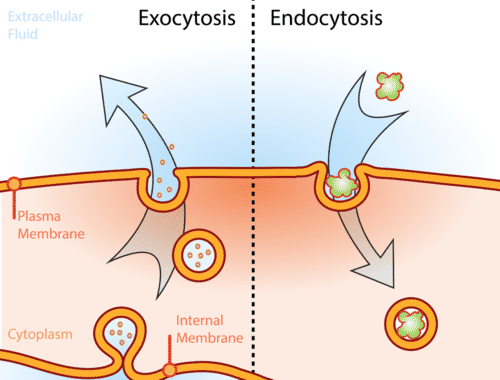CELL COMMUNICATION
CELL COMMUNICATION
Cells communicate by sending and receiving signals. Signals may come from the environment, or they may come from other cells. In order to trigger a response, these signals must be transmitted across the cell membrane. Sometimes the signal itself can cross the membrane. Other times the signal works by interacting with proteins receptors that contact both the outside and inside of the cell. In this case, only cells that have the correct receptors on their surfaces will respond to the signal.
There are a few different types of cell-cell interactions. Some of these interactions are meant for big molecules that enter and exit the cell called, endocytosis (entering the cell) and exocytosis (exiting the cell). For smaller particles like amino acids, water, ions and other solutes there are different types of direct contact between the cells called gap junctions.
Exocytosis
It is a process used by the cell to take out it’s trash and to incorporate proteins into the cell membrane. During exocytosis, the phospholipid bilayer of the cell membrane surrounds the waste proteins, creating a bubble-like structure called a vesicle. Vesicles are frequently used in the cell for transportation of molecules across the cell membrane.
Endocytosis
It is the opposite process of exocytosis. Endocytosis brings molecules into the cell. These molecules are important for the survival of the cell, such as glucose. There are three different styles of endocytosis: 1) phagocytosis, 2) pinocytosis, and 3) receptor-mediated endocytosis.
*Phagocytosis where the cell engulfs a molecule in order to move it to the interior of the cell. The process starts by the molecule binding to specific receptors on the surface of the cell membrane, triggering the cell membrane to reshape, surrounding the molecule. The receptors allow this process to be specific, controlling what can enter the cell. Then, the two ends of the cell fuse, creating a vesicle that surrounds the molecule. Eventually the membrane around the molecule will be digested and its contents will be used! For example, white blood cells recognize pathogens, such as viruses or bacterial cells, outside of the cell and will use phagocytosis to destroy it.
*Pinocytosis is how the cell drinks. Pinocytosis engulfs dissolved ions and other solutes in the liquid medium surrounding the cell. This is different than phagocytosis, which brings full, undissolved or insoluble molecules into the cell. The distortion of the cell membrane to engulf the dissolved solutes is similar to that of phagocytosis.
Cell junctions
There are many different ways that cells can connect to each other. The three main ways for cells to connect with each other are: gap junctions, tight junctions, and desmosomes. These types of junctions have different purposes:
*Gap junctions:are essentially tubes that join two cells together. These tubes create a connection that allows for the transport of water and ions to and from the connecting cells. The tubes also help to spread electrochemical signals that are produced by action potentials that occur in the nervous system (neurons) and in cardiac cells that make your heart beat.
*Gap junctions:are essentially tubes that join two cells together. These tubes create a connection that allows for the transport of water and ions to and from the connecting cells. The tubes also help to spread electrochemical signals that are produced by action potentials that occur in the nervous system (neurons) and in cardiac cells that make your heart beat.
*Tight junctions:are different from gap junctions because they are the connections that form when cells are squished up against one another. In this case, the cell membranes are connected, but the contents of each cell are not connected in any way. There are no tubes here, but there is an impermeable layer in between the cells. These types of cell connections are useful in places that need to contain certain fluids, like in the bladder, the intestines or the kidneys.
*Desmosomes:with desmosomes, cell membranes are connected by thread like substances that connect the cells across the space in between cells. Much like tight junctions, desmosomes physically hold the cells together, but do not allow fluids or materials to pass from the inside of one cell to the next. This is convenient for areas of our body that experience high stress like in our skin or our intestines because the space in between the cells offer flexibility that the other junctions can’t.
- Intacrine signals are produced by the target cell that stay within the target cell.
- Autocrine signals are produced by the target cell, are secreted, and affect the target cell itself via receptors. Sometimes autocrine cells can target cells close by if they are the same type of cell as the emitting cell. An example of this are immune cells.
- Juxtracine signals target adjacent (touching) cells. These signals are transmitted along cell membranes via protein or lipid components integral to the membrane and are capable of affecting either the emitting cell or cells immediately adjacent.
- Paracrine signals target cells in the vicinity of the emitting cell. Neurotransmitters represent an example.
- Endocrine signals target distant cells. Endocrine cells produce hormones that travel through the blood to reach all parts of the body.




Comentarios
Publicar un comentario